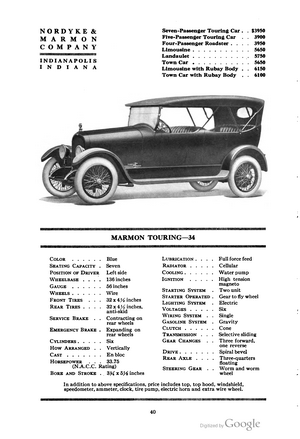















Marmon |
|---|
|
| Topic Navigation |
|---|
|
Wikipedia: Marmon Motor Car Company
Page Sections History Images |
History
The following section is an excerpt from Wikipedia's Marmon Motor Car Company page on 5 April 2016, text available via the Creative Commons Attribution-ShareAlike 3.0 Unported License.
Marmon Motor Car Company was an American automobile manufacturer founded by Howard Marmon and owned by Nordyke Marmon & Company of Indianapolis, Indiana, US. It was established in 1902 and was merged and renamed in 1933. They produced cars under the Marmon brand. It was succeeded by Marmon-Herrington and later the Marmon Motor Company of Denton, Texas. The name currently survives through the Marmon Group of Chicago, Illinois.
Marmon Cars
Marmon's parent company was founded in 1851 manufacturing flour grinding mill equipment, and branching out into other machinery through the late 19th century. Small limited production of experimental automobiles began in 1902, with an air-cooled V-twin engine. An air-cooled V4 followed the next year, with pioneering V6 and V8 engines tried over the next few years before more conventional straight engine designs were settled upon. Marmons soon gained a reputation as a reliable, speedy upscale car.
The Model 32 of 1909 spawned the Wasp. The Wasp, driven by Marmon engineer Ray Harroun (a former racer who came out of retirement for just one race), was the winner of the first ever Indianapolis 500 motor race in 1911. This car featured the world's first known automobile rear-view mirror.
The 1913 Model 48 was a left-hand steering tourer with a cast aluminum body and electric headlights and horn, as well as electric courtesy lights for the dash and doors. It used a 573 in3 (9382 cc) (4½×6-inch, 114×152 mm) T-head straight-6 engine of between 48 and 80 hp (36 and 60 kW) with dual-plug ignition and electric starter. It had a 145 in (3683 mm) wheelbase (long for the era) and 36×4½-inch (91×11.4 cm) front/37×5-inch (94×12.7 cm) rear wheels (which would interchange front and rear) and full-elliptic front and ¾-elliptic rear springs. Like most cars of the era, it came complete with a tool kit; in Marmon's case, it offered jack, power tire pump, chassis oiler, tire patch kit, and trouble light. The 48 came in a variety of models: two-, four-, five-, or seven-passenger tourers at US$5000, seven-passenger limousine at US$6250, seven-passenger landaulette at US$6350, and seven-passenger Berlin limousine at US$6450. (By contrast, a Colt Runabout was US$1500, an Enger 40 US$2000, and American's base model was US$4250.)
The 1916 Model 34 used an aluminum straight-6, and used aluminum in the body and chassis to reduce overall weight to just 3295 lb (1495 kg). A Model 34 was driven coast to coast as a publicity stunt, beating Erwin "Cannonball" Baker's record to much fanfare.
New models were introduced for 1924, replacing the long-lived Model 34, but the company was facing financial trouble, and in 1926 was reorganized as the Marmon Motor Car Co.
In 1929, Marmon introduced an under-$1,000 straight-eight car, the Roosevelt, but the stock market crash of 1929 made the company's problems worse. Howard Marmon had begun working on the world's first V16 engine in 1927, but was unable to complete the production Sixteen until 1931. By that time, Cadillac had already introduced their V-16, designed by ex-Marmon engineer Owen Nacker. Peerless, too, was developing a V16 with help from an ex-Marmon engineer, James Bohannon.
The Marmon Sixteen was produced for three years. The engine displaced 491 in³ (8.0 L) and produced 200 hp (149 kW). It was an all-aluminum design with steel cylinder liners and a 45° bank angle.
Marmon became notable for its various pioneering works in automotive manufacturing, for example it is credited with having introduced the rear-view mirror as well as pioneering the V16 engine and the use of aluminum in auto manufacturing. The historic Marmon Wasp race car of the early 20th century was also a pioneering work of automobile engineering, as it was the world's first car that utilized a single-seater "monoposto" construction layout.
 |
Marmon Touring 34 Hand Book of Automobiles, 1919 Edition View Marmon Touring 34 page of Hand Book of Automobiles, 1919 Edition - 655KB |
